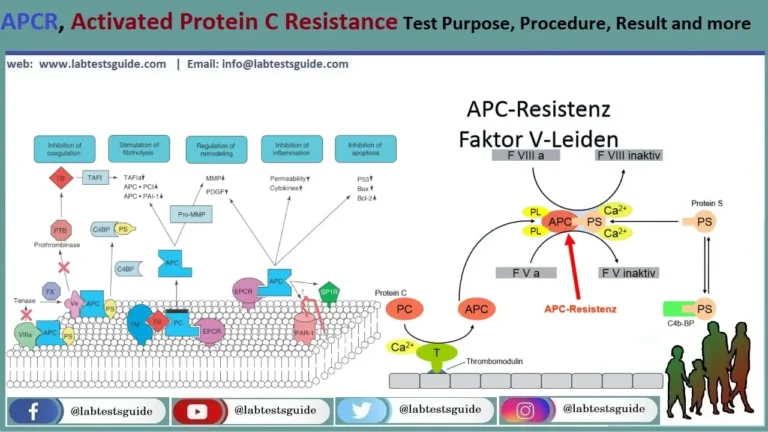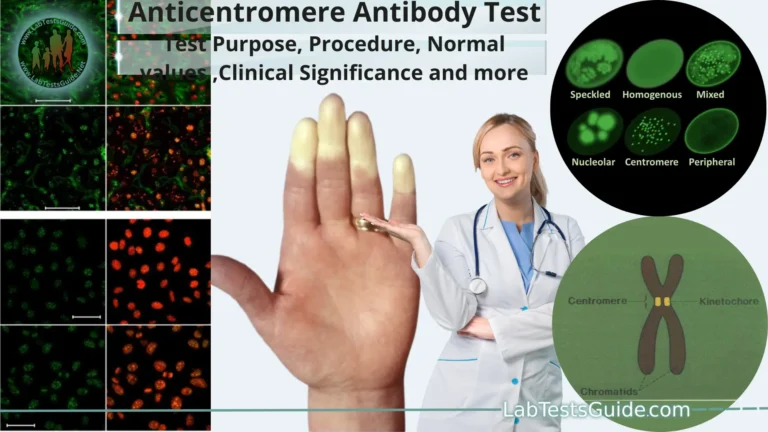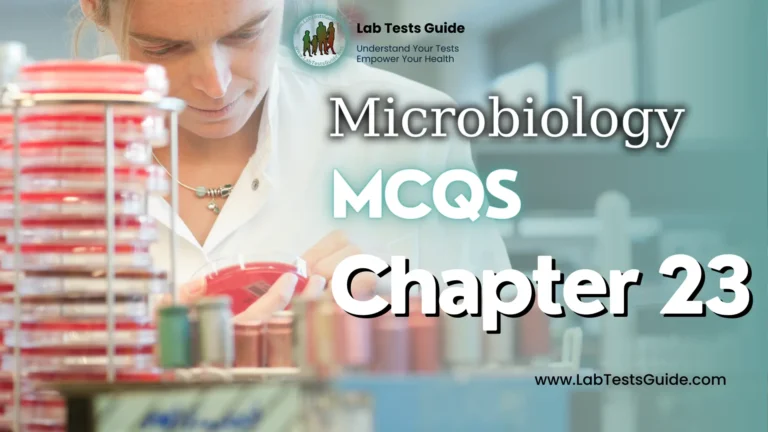6001 to 6050 MCQs for Lab Technician and Technologist Exam Preparation
5000 Plus MCQs for Lab Technician and Technologists are designed to test the knowledge and proficiency of laboratory professionals who work in the field of clinical laboratory science. These questions cover a wide range of topics related to laboratory science, including anatomy, physiology, microbiology, chemistry, and hematology.

If You like then share this to your friends and other social media.
If You have any question and suggestions then please Contact us Here
Questions 6001 to 6050
- Which one of the following is not a phospholipid?
- Lecithin
- Plasmalogen
- Lysolecithin
- Gangliosides ✔
- A fatty acid which is not synthesized in human body and has to be supplied in the diet:
- Palmitic acid
- Oleic acid
- Linoleic acid ✔
- Stearic acid
- In cephalin, choline is replaced by
- Serine
- Ethanolamine ✔
- Betaine
- Sphingosine
- The triacyl glycerol present in plasma lipoproteins are hydrolyzed by
- Linqual lipase
- Pancreatic lipase
- Colipase
- Lipoprotein lipase ✔
- Amphiphatic lipids are
- Hydrophilic
- Hydrophobic
- Both (Hydrophilic ) and (Hydrophobic) ✔
- Lipophilic
- Which of the following is not essential fatty acid?
- Oleic acid ✔
- Linoleic acid
- Arachidonic acid
- Linolenic acid
- The calorific value of lipid is
- 4.0 Kcal/gm
- 6.0 Kcal/gm
- 9.0 Kcal/gm✔
- 15 Kcal/gm
- Rancidity of butter is prevented by the addition of
- Vitamin D
- Tocopherols ✔
- Presence of priotin
- Presence of ‘Cu’
- Sphingomyelins on hydrolysis yields
- Glycerol, fatty acids, phosphoric acid and choline
- Glycerol, sphingosine, choline and fatty acids
- Sphingosine, phosphoric acid, Glycerol and inositol
- Sphingosine, fatty acids, phosphoric acid and choline ✔
- Inherited deficiency of enzyme cerebrosidase produces
- Fabry’s disease
- Niemann pick disease
- Gaucher’s disease ✔
- Tay-sach’s disease
- Phosphatidic acid on hydrolysis yields
- Glycerol, fatty acids, phosphoric acid, choline
- Glycerol, fatty acids, phosphoric acid ✔
- Glycerol, fatty acids, phosphoric acid, Glucose
- Sphingol, fatty acids, phosphoric acid
- The maximum number of double bonds present in essential fatty acid is
- 1
- 2
- 3 ✔
- 4
- Cerebrosides are composed of
- Sphingosine, fatty acids, glycerol and phosphoric acid
- Sphingosine, fatty acids, galactose ✔
- Glycerol, fatty acids, galactose
- Glycerol, fatty acids, galactose, sphingol
- Acetoacetic acid and β-OH butyric acid are formed as
- Kidneys
- Heart
- Liver✔
- Intestine
- Which amino acid is a lipotropic factor?
- Lysine
- Leucine
- Tryptophan
- Methionine ✔
- The class of lipoproteins having a beneficial effect in atherosclerosis is
- Low density of lipoproteins
- very low density lipoproteins
- High density lipoproteins ✔
- Chylomicrons
- Cholesterol is the precursor for the biosynthesis of
- fatty acid
- prostaglandins
- bile acids ✔
- sphingmyelin
- Which of the following condition is characterized by ketonuria but without glycosuria?
- Diabetes mellitus
- Diabetes insipidus
- Prolonged starvation ✔
- Addison’s disease
- Ketone bodies are formed in
- Kidney
- Liver ✔
- Heart
- Intestines
- Changes in serum high density lipoproteins (HDL) are more truly reflected by those of
- HDL-1
- HDL-2 ✔
- HDL-3
- HDLC
- Mitochondrial lipogenesis requires
- bicarbonate
- biotin ✔
- acetyl CoA carboxylase
- NADPH
- Fatty acids having chain length of 10 carbon atoms enter the
- Portal ciruclation ✔
- Lacteals
- Systemic circulation
- Colon
- A soluble system for synthesis of fatty acids have been isolated from avian liver, required for the formation of long chain fatty acids by this system is
- ATP
- Acetyl CoA
- NADPH
- All of these ✔
- Most animal tissues contain appreciable amounts of lipid, when in the form of depot fat it consists largely of
- Cholesterol ester
- Phosphatides
- C hylomicrons
- Triacylglycerol ✔
- A fatty acid not synthesized in man is
- Oleic
- Palmitic
- Linoleic ✔
- Stearic
- The ‘free fatty acids’ (FFA) of plasma:
- metabolically inert
- mainly bound to β-lipoproteins
- stored in the fat
- mainly bound to serum albumin ✔
- Adipose tissue which is a store house for triacyl glycerol synthesis the same using
- The glycerol released by hydrolysis of triacyl glycerol
- The glycerol-3-phosphate obtained in the metabolism of glucose ✔
- 2-phosphoglycerate
- 3-phosphoglycerate
- Increase in blood of this class of lipoproteins is beneficial to ward off coronary heart disease:
- HDL ✔
- LDL
- VLDL
- IDL
- In the extra mitochondrial synthesis of fatty acids, CO2 is utilized
- To keep the system anaerobic and prevent regeneration of acetyl CoA
- In the conversion of malonyl to CoA hydroxybutyryl CoA ✔
- In the conversion of acetyl CoA to malonyl CoA
- In the formation of acetyl CoA from 1 carbon intermediates
- Current concepts concerning the intestinal absorption of triacylglycerols are that
- They must be completely hydrolysed before the constituent fatty acids can be absorbed
- They are hydrolysed partially and the material absorbed consists of free fatty acids, mono and diacyl glycerols and unchanged triacyl glycerols✔
- Fatty acids with less than 10 carbon atoms are absorbed about equally via lymph and via portal blood
- In the absence of bile the hydrolysis of triacyl glycerols is absorbed
- Main metabolic end product of cholesterol:
- Coprosterol
- 5-pregnenolone
- Bile acid ✔
- Glycine
- In the type II (a) hyper lipoproteinemia there is increase in
- Chylomicron bond
- β ✔
- Pre beta
- α
- Normal fat content of liver is about _ gms %.
- 5 ✔
- 8
- 10
- 15
- Obesity is accumulation of _ in the body.
- Water
- NaCl
- Fat ✔
- Proteins
- The first lipoprotein to be secreted by the liver is
- VLDL
- nascent VLDL ✔
- LDL
- IDL
- This lipoprotein removes cholesterol from the body
- HDL ✔
- VLDL
- IDL
- Chylomicrons
- When the stired triacylglycerol is lipolysed in the adipose tissue blood levels of _ increased.
- FFA only ✔
- Glycerol only
- Free fatty acids (FFA) and Glycerol
- Triacyl glycero
- All long chain fatty acids with even number of carbon atoms are oxidized to a pool of _ by β-oxidation.
- CO2
- Propionic acid
- Acetic acid
- Acetyl CoA✔
- The level of free fatty acids in plasma is increased by
- Insulin
- Caffeine ✔
- Glucose
- Niacin
- Cholesterol is excreted as such into __.
- Urine
- Faeces ✔
- Bile
- Tears
- LCAT is
- Lactose choline alamine transferse
- Lecithin cholesterol acyl transferase ✔
- Lecithin carnitine acyl transferase
- Lanoleate carbamoyl acyl transferase
- Cholesterol molecule has _ carbon atoms.
- 27 ✔
- 21
- 15
- 12
- A hydrocarbon formed in cholesterol synthesis is
- Mevalonate
- HMG CoA
- Squalene ✔
- Zymosterol
- While citrate is converted to isocitrate in the mitochondria, it is converted to _ in the cytosol.
- Acetyl CoA + oxaloacetate ✔
- Acetyl CoA + malonyl CoA
- Acetyl CoA + Pyruvate
- Acetyl CoA + acetoacetyl CoA
- Avidin is antigonistic to
- Niacin
- PABA
- Biotin ✔
- Pantothenic acid
- CTP is required for the synthesis of
- Fatty acids
- Proteins
- Phospholipids ✔
- Cholesterol
- Lysolecithin is formed from lecithin by the action of
- Phospholipase A1
- Phospholipase A2 ✔
- Phospholipase C
- Phospholipase D
- Fatty acids can not be converted into carbohydrates in the body, as the following reaction is not possible:
- Conversion of glucose-6-phosphate into glucose
- Fructose 1, 6 diphosphate to fructose-6- phosphate
- Transformation of acetyl CoA to pyruvate ✔
- Formation of acetyl CoA from fatty acids
- Cholesterol circulates in blood stream chiefly as
- Free cholesterol
- Ester cholesterol
- Low density lipoproteins
- Low density lipoproteins and high density lipoproteins ✔
- What is the sub cellular site for the βoxidation of fatty acids?
- Nucleus
- Mitochondria ✔
- Lysosome
- Cytosol
The questions are typically designed to assess the technical skills and knowledge required for the laboratory profession, including the ability to analyze laboratory test results, perform laboratory procedures, and maintain laboratory equipment.
To prepare for these MCQs, candidates should have a thorough understanding of the key concepts and principles of laboratory science. They should also be familiar with common laboratory equipment and procedures, as well as laboratory safety protocols.
Candidates may also benefit from studying specific laboratory science textbooks or taking online courses that cover the material tested in the MCQs. Additionally, practicing sample MCQs and reviewing the answers can help candidates identify areas where they may need to improve their knowledge or skills.
Overall, the MCQs for lab technologists are designed to be challenging and comprehensive, requiring candidates to demonstrate a high level of proficiency in the field of laboratory science.
Possible References Used






